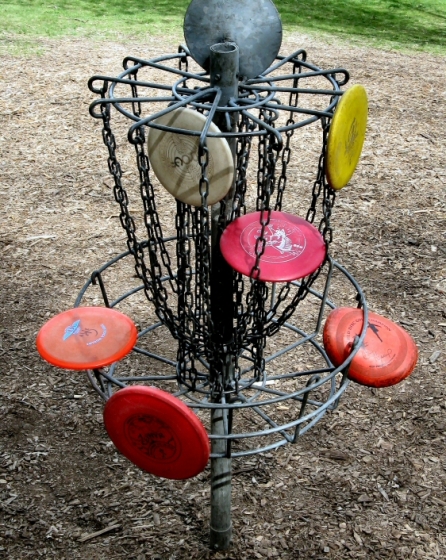Harrishabitat
PDGA Numbers 60630 AND 34207
- Joined
- Aug 27, 2009
- Messages
- 678
I am not the biggest fan of the PDGA...A lot of reasons some professional some personal, I don't want to get into the details, it really doesn't pertain to this.
I got in the middle of a conversation with a local club about something that happened at a round recently. It was on a short, blind hole. When they arrived at the basket one of their drives (with a putter) was wedged in the side of the basket. They contacted the PDGA rules guru to ask about this and then also asked members of the group. Of course I replied that it is not holed out because the rules state it must be supported by the bottom of the basket (or chains or pole) which is how the rule is worded as well as the rules Q&A which shows this as a shot that is not holed out. So then they got this response from the official PDGA rules guru...
"Q&A #34 is written using a disc that ends up in the bottom of the tray as an example, but it can be extended to apply to any position a disc ends up in. I'd rule the ace good given the rule and the Q&A's as they are currently written. Q&A #34 tells us that since no one saw the disc approach the target, we can't assume how it got to its resting position. It is possible (though unlikely) that the disc you describe entered the target correctly between the top of the tray and the bottom of the chain support. The next question is whether a disc wedged in the side of the tray is good. The rule includes "inside wall" as something that can support the disc, and an argument can be made that a disc wedged in the side is at least somewhat supported by the inside wall. The assumption in Q&A #41 is that the wedged disc in the picture entered from outside the target."
I have to say to get that reply from the PDGA rules official is confusing at best. Is there something here that I am missing or just another example of the PDGA that can't even agree with itself?
I got in the middle of a conversation with a local club about something that happened at a round recently. It was on a short, blind hole. When they arrived at the basket one of their drives (with a putter) was wedged in the side of the basket. They contacted the PDGA rules guru to ask about this and then also asked members of the group. Of course I replied that it is not holed out because the rules state it must be supported by the bottom of the basket (or chains or pole) which is how the rule is worded as well as the rules Q&A which shows this as a shot that is not holed out. So then they got this response from the official PDGA rules guru...
"Q&A #34 is written using a disc that ends up in the bottom of the tray as an example, but it can be extended to apply to any position a disc ends up in. I'd rule the ace good given the rule and the Q&A's as they are currently written. Q&A #34 tells us that since no one saw the disc approach the target, we can't assume how it got to its resting position. It is possible (though unlikely) that the disc you describe entered the target correctly between the top of the tray and the bottom of the chain support. The next question is whether a disc wedged in the side of the tray is good. The rule includes "inside wall" as something that can support the disc, and an argument can be made that a disc wedged in the side is at least somewhat supported by the inside wall. The assumption in Q&A #41 is that the wedged disc in the picture entered from outside the target."
I have to say to get that reply from the PDGA rules official is confusing at best. Is there something here that I am missing or just another example of the PDGA that can't even agree with itself?
